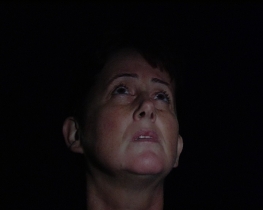Untitled, 2005 by Júlia Ventura would appear to displace a series of concerns identifiable in the photographic work she has developed over the last two decades onto video. That, however, is an interpretation that does it little justice. Video is, after all, an almost unusual medium in her work as a whole.
Since the end of the 1970s, Júlia Ventura has been working exclusively on the theme of self-representation and the demystification of her humanist understanding, achieved by means of a subtle and cutting reflection on the conditions of representation, whether relative to semiotic procedures or social, cultural and image-bearing stereotypes. Her photographic, pictorial or wallpaper work can recount or ironise the constructions of identity through the multiple interlinkings of an inventory of the configurations of her own face, of fingerprints on canvas, of stamps with her profile pulling a face whose tongue almost touches the tip of its nose, or of decorative patterns on wallpaper.
The face and the finger are thus constantly indexed and therefore tangible to the most diverse inscribed surfaces that determine, within the framework of a technological context of image production, the perceptive possibilities of the identifications underway. The uses of these media are not irrelevant for this. Contrary to the traditional perception of this tangibility, it is not the referent (the face, the fingerprint) that is limited to imprinting something of itself, but rather the producing of this impression that configures it.
Júlia Ventura also associated these aspects to others from an obsolete and stereotyped imagery, as with the moonlight as luminous substance of the photographic process and simultaneously symbolic stereotype of the female polarity that impresses her body. Full Moon Photos (1994-2003) presents her in several poses that are recurrent but transfigured by the circumstances imposed. In these photographs, the tension provoked by the movements of the face and the slow exposure of the film causes the phantasmagorical, at times almost pictorialist, aspect of the image. But we are not dealing with revivalism here, except where inscribing or imprinting the movement in a medium apparently destined to suppress it at that very instant. And the instant dissolves in its impossibility, in this infinite frontier between past and future, returning the spectrality to photography.
In Untitled, 2005, it is also the moonlight that acts as the luminous substance for the pictorial faces that emerge from the black background with a 16th-century look and differentiated between the mystical, the neutral and the grimacing. But the three images in this work are set objectively in time, even if the three poses of the face are shown to be as static as their performance permits. The crossing over of Ventura's most recurring photographic iconography onto video now transfers, through the attempt to make movement absent, an ambiguity onto the medium. Video draws infinitely towards photography. Even so, time slips away and a tension is insinuated, but there is no progression or narrative.
Whereas in Andy Warhol’s film portraits the figures with their small and relaxed movements are captured in front of the camera, in Untitled, 2005 they try to escape from this experiential condition by a pose that has a static image as anteriority. It is in the drawing towards this timeless image, photographic and consigned to the ‘that was’, that they vacillate and constantly reveal themselves in a present that implies the continued constitution of the image that informs them. They flow therefore from one time to another, emptying the fiction of an absolute present that characterises the medium’s more traditional conventions, the ‘this is happening’. Thus can the image make visible the coarse being of the temporal substance that constitutes it, i.e., the spectrality of its present.
Pedro Lapa











